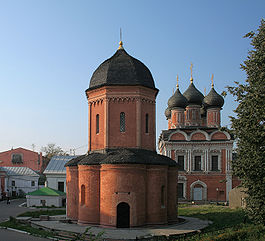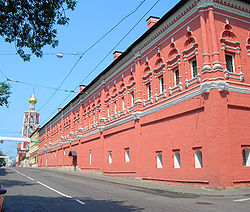
Vysokopetrovsky Monastery
Encyclopedia

Monastery
Monastery denotes the building, or complex of buildings, that houses a room reserved for prayer as well as the domestic quarters and workplace of monastics, whether monks or nuns, and whether living in community or alone .Monasteries may vary greatly in size – a small dwelling accommodating only...
in the Bely Gorod
Bely Gorod
Bely Gorod is the central core area of Moscow, Russia. The name comes from the color of its defensive wall, which was erected in 1585-1593 at the behest of tsar Feodor I and Boris Godunov by architect Fyodor Kon...
of Moscow
Moscow
Moscow is the capital, the most populous city, and the most populous federal subject of Russia. The city is a major political, economic, cultural, scientific, religious, financial, educational, and transportation centre of Russia and the continent...
commanding a hill whence Petrovka Street
Petrovka Street
Petrovka Street is a street in Moscow, Russia, that runs north from Kuznetsky Most and Theatral Square up past Strastnoy Boulevard and Petrovsky Boulevard....
descends towards the Kremlin.
The monastery is believed to have been founded in the 1320s by Saint Peter of Moscow
Metropolitan Peter
Saint Peter, Metropolitan of Moscow and all Russia was the Russian metropolitan who moved his see from Vladimir to Moscow in 1325. Later he was proclaimed a patron saint of Moscow. In spite of the move, the office remained officially entitled "Metropolitan of Kiev and All Rus'" until the...
, the first Russian metropolitan to move his see in Moscow. The cloister gave its name to adjacent Petrovka Street, one of the streets radiating from Red Square
Red Square
Red Square is a city square in Moscow, Russia. The square separates the Kremlin, the former royal citadel and currently the official residence of the President of Russia, from a historic merchant quarter known as Kitai-gorod...
.
In the late 17th century, the Naryshkin
Naryshkin
Naryshkin is a Russian surname and may refer to:* Members of the Naryshkin family* Sergey Naryshkin , a politician* Two men of the name Kirill Naryshkin...
boyars, maternal relatives of Peter the Great, turned the monastery into their family burial place. They had it reconstructed in the Naryshkin Baroque
Naryshkin Baroque
Naryshkin Baroque, also called Moscow Baroque, or Muscovite Baroque, is the name given to a particular style of Baroque architecture and decoration which was fashionable in Moscow from the turn of the 17th into the early 18th centuries.-Style:...
style of architecture associated with their name. In the mid-18th century, several subsidiary structures were added, conceivably to designs by Dmitry Ukhtomsky
Dmitry Ukhtomsky
Prince Dmitry Vasilyevich Ukhtomsky, Дмитрий Васильевич Ухтомский was the chief architect of Moscow, Russia during the reign of Empress Elizabeth.-Biography:...
or Ivan Fyodorovich Michurin
Ivan Fyodorovich Michurin
Ivan Fyodorovich Michurin was a Russian architect whose designs marked a transition of Russian architecture from early Muscovite Baroque to mature Rastrelliesque style....
.
The katholikon, dedicated to St Peter of Moscow, was long regarded as a typical monument of the Naryshkin style and dated to 1692. In the 1970s the detailed studies of sources and excavations of the site revealed that the katholikon had been actually built in 1514-1517 by Aloisio the New
Aloisio the New
Aloisio the New, known in Russian as Aleviz Novyi or Aleviz Fryazin, was an Italian Renaissance architect invited by Ivan III to work in Moscow...
.

Russian Orthodox Church
The Russian Orthodox Church or, alternatively, the Moscow Patriarchate The ROC is often said to be the largest of the Eastern Orthodox churches in the world; including all the autocephalous churches under its umbrella, its adherents number over 150 million worldwide—about half of the 300 million...
. As of 2005, the buildings are shared by the Russian Orthodox Church
Russian Orthodox Church
The Russian Orthodox Church or, alternatively, the Moscow Patriarchate The ROC is often said to be the largest of the Eastern Orthodox churches in the world; including all the autocephalous churches under its umbrella, its adherents number over 150 million worldwide—about half of the 300 million...
and the Moscow Literature Museum.
Structures
- Cathedral of St Peter (1517).
- Church of Our Lady of BogolyubovoTheotokos of BogolyubovoThe Bogolubskaya Icon of the Theotokos is a Wonderworking Icon of the Theotokos which is venerated in the Russian Orthodox Church...
(with a refectoryRefectoryA refectory is a dining room, especially in monasteries, boarding schools and academic institutions. One of the places the term is most often used today is in graduate seminaries...
) (1687) - Church of St. Sergius of Radonezh (with a refectoryRefectoryA refectory is a dining room, especially in monasteries, boarding schools and academic institutions. One of the places the term is most often used today is in graduate seminaries...
) (1694) - Church of St. Pachomius the GreatPachomiusSaint Pakhom , also known as Pachome and Pakhomius , is generally recognized as the founder of Christian cenobitic monasticism. In the Coptic churches his feast day is celebrated on May 9...
above the monastery gates (1755) - Church of Our Lady of Tolga (1750)
- Church of the Intercession above the monastery gates, with a belltower. (1694)
- Church (former chapel) of Our Lady of KazanOur Lady of KazanOur Lady of Kazan, also called Theotokos of Kazan , was a holy icon of the highest stature within the Russian Orthodox Church, representing the Virgin Mary as the protector and patroness of the city of Kazan. Copies of the image are also venerated in the Catholic Church...
(inside the former gates under the belltower).

